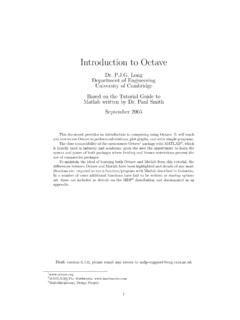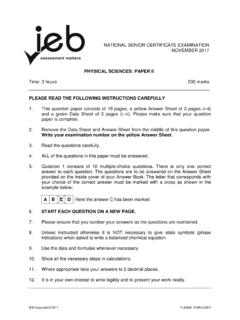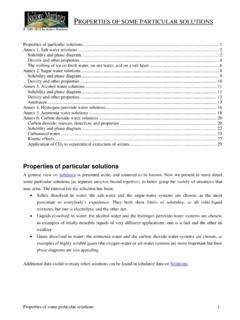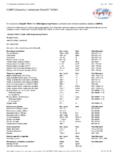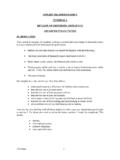Transcription of Materials Data Book - University of Cambridge
1 1. Materials data book 2003 Edition Cambridge University Engineering Department 2. PHYSICAL CONSTANTS IN SI UNITS. Absolute zero of temperature C. Acceleration due to gravity, g 9. 807 m/s2. Avogadro's number, N A /kmol Base of natural logarithms, e Boltzmann's constant, k x 10 26 kJ/K. Faraday's constant, F x 107 C/kmol Universal Gas constant, R kJ/kmol K. Permeability of vacuum, o x 10 6 H/m Permittivity of vacuum, o x 10 12 F/m Planck's constant, h x 10 37 kJ/s Velocity of light in vacuum, c x 108 m/s Volume of perfect gas at STP m3/kmol CONVERSION OF UNITS. Angle, 1 rad . Energy, U See inside back cover Force, F 1 kgf N. 1 lbf N. Length, l 1 ft mm 1 inch mm 1 nm Mass, M 1 tonne 1000 kg 1 lb kg Power, P See inside back cover Stress, See inside back cover Specific Heat, Cp 1 cal/g. C Stress Intensity, K 1 ksi in MPa m Temperature, T 1 F K. Thermal Conductivity, 1 Volume, V 1 Imperial gall x 10 3 m3.
2 1 US gall x 10 3 m3. Viscosity, 1 poise 1 lb 1. CONTENTS. Page Number Introduction 3. Sources 3. I. FORMULAE AND DEFINITIONS. Stress and strain 4. Elastic moduli 4. Stiffness and strength of unidirectional composites 5. Dislocations and plastic flow 5. Fast fracture 6. Statistics of fracture 6. Fatigue 7. Creep 7. Diffusion 8. Heat flow 8. II. PHYSICAL AND MECHANICAL PROPERTIES OF Materials . Melting temperature 9. Density 10. Young's modulus 11. Yield stress and tensile strength 12. Fracture toughness 13. Environmental resistance 14. Uniaxial tensile response of selected metals and polymers 15. III. material PROPERTY CHARTS. Young's modulus versus density 16. Strength versus density 17. Young's modulus versus strength 18. Fracture toughness versus strength 19. Maximum service temperature 20. material price (per kg) 21. IV. PROCESS ATTRIBUTE CHARTS. material -process compatibility matrix (shaping) 22.
3 Mass 23. Section thickness 23. Surface roughness 24. Dimensional tolerance 24. Economic batch size 25. 2. V. CLASSIFICATION AND APPLICATIONS OF ENGINEERING Materials . Metals: ferrous alloys, non-ferrous alloys 26. Polymers and foams 27. Composites, ceramics, glasses and natural Materials 28. VI. EQUILIBRIUM (PHASE) DIAGRAMS. Copper Nickel 29. Lead Tin 29. Iron Carbon 30. Aluminium Copper 30. Aluminium Silicon 31. Copper Zinc 31. Copper Tin 32. Titanium-Aluminium 32. Silica Alumina 33. VII. HEAT TREATMENT OF STEELS. TTT diagrams and Jominy end-quench hardenability curves for steels 34. VIII. PHYSICAL PROPERTIES OF SELECTED ELEMENTS. Atomic properties of selected elements 36. Oxidation properties of selected elements 37. 3. INTRODUCTION. The data and information in this booklet have been collected for use in the Materials Courses in Part I of the Engineering Tripos (as well as in Part II, and the Manufacturing Engineering Tripos).
4 Numerical data are presented in tabulated and graphical form, and a summary of useful formulae is included. A list of sources from which the data have been prepared is given below. Tabulated material and process data or information are from the Cambridge Engineering Selector (CES) software (Educational database Level 2), copyright of Granta Design Ltd, and are reproduced by permission; the same data source was used for the material property and process attribute charts. It must be realised that many material properties (such as toughness) vary between wide limits depending on composition and previous treatment. Any final design should be based on manufacturers' or suppliers' data for the material in question, and not on the data given here. SOURCES. Cambridge Engineering Selector software (CES ), 2003, Granta Design Limited, Rustat House, 62 Clifton Rd, Cambridge , CB1 7EG.
5 M F Ashby, Materials Selection in Mechanical Design, 1999, Butterworth Heinemann M F Ashby and D R H Jones, Engineering Materials , Vol. 1, 1996, Butterworth Heinemann M F Ashby and D R H Jones, Engineering Materials , Vol. 2, 1998, Butterworth Heinemann M Hansen, Constitution of Binary Alloys, 1958, McGraw Hill I J Polmear, Light Alloys, 1995, Elsevier C J Smithells, Metals Reference book , 6th Ed., 1984, Butterworths Transformation Characteristics of Nickel Steels, 1952, International Nickel 4. I. FORMULAE AND DEFINITIONS. STRESS AND STRAIN. F F l l lo t = n = t = ln n =. A Ao lo lo F = normal component of force t = true stress Ao = initial area n = nominal stress A = current area t = true strain l o = initial length n = nominal strain l = current length lateral strain Poisson's ratio, = . longitudinal strain Young's modulus E = initial slope of t t curve = initial slope of n n curve.
6 Yield stress y is the nominal stress at the limit of elasticity in a tensile test. Tensile strength ts is the nominal stress at maximum load in a tensile test. Tensile ductility f is the nominal plastic strain at failure in a tensile test. The gauge length of the specimen should also be quoted. ELASTIC MODULI. E E. G= K=. 2 (1 + ) 3 (1 2 ). For polycrystalline solids, as a rough guide, 1. Poisson's Ratio . 3. 3. Shear Modulus G E. 8. Bulk Modulus K E. These approximations break down for rubber and porous solids. 5. STIFFNESS AND STRENGTH OF UNIDIRECTIONAL COMPOSITES. E II = V f E f + ( 1 V f ) E m 1. V f 1 V f . E = + . Ef Em .. ts = V f ff + ( 1 V f ) m y E II = composite modulus parallel to fibres (upper bound). E = composite modulus transverse to fibres (lower bound). V f = volume fraction of fibres E f = Young's modulus of fibres E m = Young's modulus of matrix ts = tensile strength of composite parallel to fibres ff = fracture strength of fibres m y = yield stress of matrix DISLOCATIONS AND PLASTIC FLOW.
7 The force per unit length F on a dislocation, of Burger's vector b , due to a remote shear stress , is F = b . The shear stress y required to move a dislocation on a single slip plane is cT. y = where T = line tension (about 1 G b 2 , where G is the shear modulus). bL 2. L = inter-obstacle distance c = constant ( c 2 for strong obstacles, c < 2 for weak obstacles). The shear yield stress k of a polycrystalline solid is related to the shear stress y required to move a dislocation on a single slip plane: k 32 y . The uniaxial yield stress y of a polycrystalline solid is approximately y = 2 k , where k is the shear yield stress. Hardness H (in MPa) is given approximately by: H 3 y . Vickers Hardness HV is given in kgf/mm2, HV = H / g , where g is the acceleration due to gravity. 6. FAST FRACTURE. The stress intensity factor, K : K = Y a Fast fracture occurs when K = K IC.
8 In plane strain, the relationship between stress intensity factor K and strain energy release rate G is: EG. K = EG (as 2 ). 2. 1 . E G IC. Plane strain fracture toughness and toughness are thus related by: K IC = E G IC. 1 2. 2. K IC. Process zone size at crack tip given approximately by: r p =. 2f Note that K IC (and G IC ) are only valid when conditions for linear elastic fracture mechanics apply (typically the crack length and specimen dimensions must be at least 50 times the process zone size). In the above: = remote tensile stress a = crack length Y = dimensionless constant dependent on geometry; typically Y 1. K IC = plane strain fracture toughness;. G IC = critical strain energy release rate, or toughness;. E = Young's modulus = Poisson's ratio f = failure strength STATISTICS OF FRACTURE. m dV .. Weibull distribution, Ps (V) = exp . V o Vo .. m V .. For constant stress: Ps (V) = exp.
9 O Vo .. Ps = survival probability of component V = volume of component = tensile stress on component Vo = volume of test sample o = reference failure stress for volume Vo , which gives Ps = 1 = e m = Weibull modulus 7. FATIGUE. Basquin's Law (high cycle fatigue): N f = C1. Coffin-Manson Law (low cycle fatigue): pl N f = C 2. Goodman's Rule. For the same fatigue life, a stress range operating with a mean stress m , is equivalent to a stress range o and zero mean stress, according to the relationship: m . = o 1 . ts . Miner's Rule for cumulative damage (for i loading blocks, each of constant stress amplitude and duration N i cycles): . Ni = 1. N fi i Paris' crack growth law: da = A Kn dN. In the above: = stress range;. pl = plastic strain range;. K = tensile stress intensity range;. N = cycles;. N f = cycles to failure;. , , C1 , C 2 , A, n = constants;. a = crack length.
10 Ts = tensile strength. CREEP. Power law creep: & ss = A n exp ( Q / RT ). & ss = steady-state strain-rate Q = activation energy (kJ/kmol). R = universal gas constant T = absolute temperature A, n = constants 8. DIFFUSION. Diffusion coefficient: D = Do exp ( Q / RT ). dC C 2C. Fick's diffusion equations: J = D and =D. dx t x2. C = concentration J = diffusive flux x = distance D = diffusion coefficient (m2/s). t = time Do = pre-exponential factor (m2/s). Q = activation energy (kJ/kmol). HEAT FLOW. dT. Steady-state 1D heat flow (Fourier's Law): q= . dx T 2T. Transient 1D heat flow: =a t x2. T = temperature (K) = thermal conductivity ( ). q = heat flux per second, per unit area ( ) a = thermal diffusivity (m2/s). For many 1D problems of diffusion and heat flow, the solution for concentration or temperature depends on the error function, erf : x x . C( x , t ) = f erf or T ( x , t ) = f erf.

